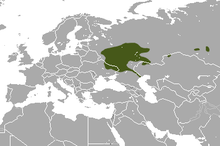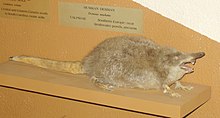Russian desman
| Russian desman | |
|---|---|

| |
| Scientific classification | |
| Domain: | Eukaryota |
| Kingdom: | Animalia |
| Phylum: | Chordata |
| Class: | Mammalia |
| Order: | Eulipotyphla |
| Family: | Talpidae |
| Genus: | Desmana |
| Species: | D. moschata[1]
|
| Binomial name | |
| Desmana moschata Linnaeus , 1758)
| |

| |
| Russian desman range | |
| Synonyms | |
|
Castor moschatus Linnaeus, 1758 | |
The Russian desman (Desmana moschata) (
social system
.
Taxonomy


The Russian desman is one of two surviving
Desmanini, the other being the Pyrenean desman.[3] Despite its outward similarity to muskrats (a rodent), the Russian desman is actually part of the mole family Talpidae in the order Eulipotyphla. Like other moles, it is functionally blind and obtains much of its sensory input from the touch-sensitive Eimer's organs at the end of its long, bilobed snout. However, the hind feet are webbed and the tail is laterally flattened —specializations for its aquatic habitat. The body is 18 to 21 cm (7.1 to 8.3 in) long while the tail is 17 to 20 cm (6.7 to 7.9 in) in length. Easily the largest species of mole, it weighs 400 to 520 g (14 to 18 oz).[citation needed
]
Decidedly rich and thick in nature, desman fur used to be highly sought after by the which?] the number of desmans appears to be increasing.[citation needed
]
Distribution and habitat
From 2009 to 2011, the Don Basin rivers were searched for Russian desman to evaluate if this environment was sustainable for the species. No evidence was found that the species lives in this area but if so, the population was very small. The limiting factors consist of global factors, interspecific processes, and new immigrating species in the river ecosystem.[5]
Characteristics
Russian desman provide comfort to themselves by grooming. More specifically, scratching with hind feet, washing, biting out of nails, and biting out of fur. The main reasons for these actions are supporting the air layer and heat-insulating properties of fur.[6]
References
- OCLC 62265494.
- ^ Rutovskaya, M.; Gazzard, A.; Turvey, S.T. (2023). "Desmana moschata". IUCN Red List of Threatened Species. 2023: e.T6506A231334630.
- ^ Morelle, Rebecca (4 September 2012). "Pyrenean desman: On the trail of Europe's weirdest beast". BBC News.
- ^ "Russians rally for water mammal". BBC News. 9 June 2006.
- S2CID 15623225.
- ^ Makhotkina, K.A (March 2013). "COMFORT BEHAVIOR OF RUSSIAN DESMAN (DESMEVA MOSCHATA)". Zoologichesky Zhurnal. 92: 313–321 – via Science Citation Index.
External links
 Media related to Desmana moschata at Wikimedia Commons
Media related to Desmana moschata at Wikimedia Commons Data related to Desmana moschata at Wikispecies
Data related to Desmana moschata at Wikispecies- ARKive - images and movies of the Russian desman (Desmana moschata)

